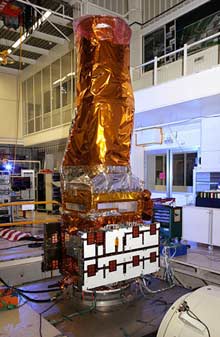Searching for Another EarthA new discovery advances the hunt for Earthlike planets beyond our solar system.
An international team of astronomers has discovered an exoplanet--one outside our solar system--that has a more Earthlike orbit than any alien planet discovered so far using the same technique.
The planet, called CoRot-9b, was discovered by the French-operated satellite CoRot, which has been in orbit since 2006. The spacecraft detected CoRot-9b by measuring the dimming of its star's brightness as the planet passed in front of it, a technique called "transit observation." The small dip in brightness allows the planet's size to be calculated. By measuring the amount of time it takes the planet to complete its orbit, researchers can determine the planet's distance from its star. The planet travels around its star every 95 Earth days, at a distance about half of that between Earth and the sun. This distance is still 10 times farther than any other planet discovered using this method. Its surface temperature is between -23 and 157 °C and, while its atmosphere could contain liquid water, CoRot-9b is made mostly of hydrogen and helium and therefore is unlikely to support life. "This is the first time that we can probe the atmosphere of such a cool planet outside the solar system," says Jason Wright, an assistant professor of astronomy at Pennsylvania State University, who was not involved in the discovery. Wright says that the finding is an important step forward in finding an Earthlike planet that could support life, one of the biggest goals in astronomy. Astronomers used ground-based telescopes in Chile, Israel, and Tenerife, a Spanish Island off the coast of Africa, to confirm their finding, and to determine the planet's mass by measuring the gravitational pull exerted on its parent star (this pull causes the star to wobble). From the mass and radius measurements, the astronomers estimated the planet's density, which is valuable in understanding its composition and structure, says Suzanne Aigrain, a lecturer in astrophysics at Oxford University and part of the team of astronomers that discovered the planet. The new planet has a rocky core, but the rest is mainly made up of hydrogen and helium, so no form of life as we know it could exist, says Aigrain. "Transit technology is state-of-the-art; it's in its prime," says Wright. "This is the first time we have detected a planet with such a long orbital period when it is so far from the star," he says. Previously discovered exoplanets orbit much closer, making them both extremely hot and hard to study. Jennifer Patient, a lecturer in astrophysics at the University of Exeter, in the U.K., says that there are two key technical challenges in imaging planets: overcoming the contrast ratio in the light from the star and the planet, and the fact that the planets are a typically quite close to the host star. |
Telescopes
See Farther
10/16/2008










Tags
NASA planets satellites spacecraft telescope